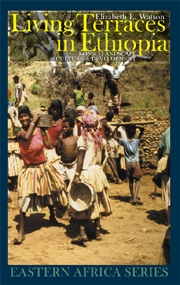Book contents
- Frontmatter
- Contents
- List of Photographs
- List of Maps, Tables & Figures
- Acknowledgements
- Foreword
- Introduction: Konso Landscape, Culture & Development
- 1 Konso Intensive Indigenous Agriculture
- 2 Social Life of Agriculture
- 3 Ritual Life of Agriculture
- 4 Political Life of Agriculture
- 5 Modernity & Christianity
- 6 Revolutionary State
- 7 Ethnic Decentralization & Self-determination
- Conclusion: Landscape, Meaning & Development
- References
- Index
Conclusion: Landscape, Meaning & Development
Published online by Cambridge University Press: 12 September 2012
- Frontmatter
- Contents
- List of Photographs
- List of Maps, Tables & Figures
- Acknowledgements
- Foreword
- Introduction: Konso Landscape, Culture & Development
- 1 Konso Intensive Indigenous Agriculture
- 2 Social Life of Agriculture
- 3 Ritual Life of Agriculture
- 4 Political Life of Agriculture
- 5 Modernity & Christianity
- 6 Revolutionary State
- 7 Ethnic Decentralization & Self-determination
- Conclusion: Landscape, Meaning & Development
- References
- Index
Summary
The last three chapters focused on the changes that have unfolded in Konso, and the way they have impacted on the institutions that are central to the production of Konso indigenous agriculture and landscape. Together with the earlier chapters, they emphasize the way in which material struggles over land and labour are played out in discursive struggles over the legitimacy of different beliefs and forms of identification (Konso ‘custom’, Protestant Christian, Orthodox Christian). In this conclusion, I return more explicitly to the landscape and examine what can be learnt from the material presented here about how landscapes like Konso are produced and maintained over time. I also explore the significance of this account for development practice and policy.
The principal message is that the terraced landscape of Konso is a cultural landscape; it is produced out of networks of collaborative action which are also networks of meaning. Historically, the indigenous institution of the poqalla has been central to the network of meaning, and has helped to produce the landscape and the indigenous intensive landscape that it supports. The poqallas have been powerful institutions because they were intimately connected to others in Konso, who identified with them personally: the poqallas were their relatives; they represented, structurally, every Konso person's father and their origins. The poqallas also performed multiple functions, providing material, juridical, social and cultural support. In rituals, the poqallas were thought to be able to influence forces beyond the control of ordinary mortals.
- Type
- Chapter
- Information
- Living Terraces in EthiopiaKonso Landscape, Culture and Development, pp. 217 - 224Publisher: Boydell & BrewerPrint publication year: 2009



